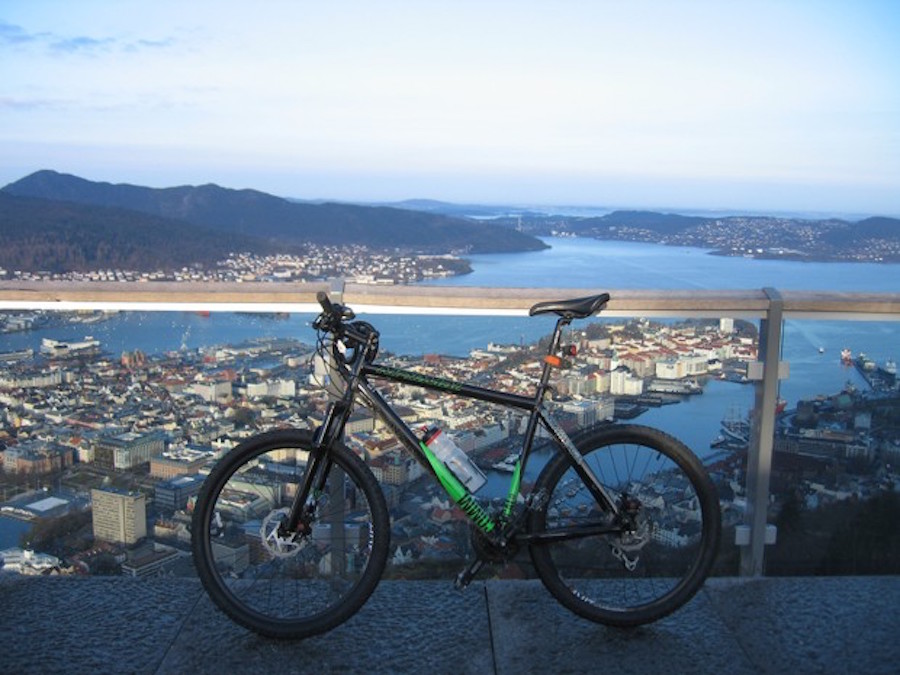Norway has just announced a new tool in its fight against transit emissions: a new network of bike highways.

As part of a plan announced last week, the country will spend a massive 8 billion Norwegian Kroner ($923 million) creating 10 broad, two-lane, cross-country bike tracks in and near Norway’s nine largest cities, allowing longer-distance cyclists to travel with a speed and safety hitherto impossible. A key component of plans to slash Norway’s transit emissions by half, the bike highway scheme still faces some resistance. Not only is cycling in Norway relatively uncommon by Scandinavian standards, but the new highways will be constructed in a mountainous country that is cold and dark for much of the year.
First, it’s important to be clear about what’s being planned. In keeping with the emerging European definition of the term “bike highway” (“super cycleway” in Norwegian), these will not be tracks linking far-flung cities across hundreds of miles, at least not at this initial stage. What the new paths will do is create bike commuter links between inner cities and outer suburbs, extending the protected cycle network out from urban cores through the commuter belt and into the countryside beyond.
These broad, twin-lane tracks will do more than offer protection, per se. They’ll allow cyclists to speed up safely, riding at up to 40 kilometers (25 miles) per hour and thus making longer commutes feasible. If they succeed, they should take pressure off roads and public transit and help to cut Norway’s fossil fuel use.
From our partners:
Norway’s plan thus won’t lumber the country with pretty but exorbitantly expensive long-distance cycleways that nobody but the odd intrepid tourist would use. It still faces some pretty strong obstacles. While Norway isn’t quite as chilly as you might expect—the Gulf Stream’s warmth keeps the coast largely ice-free year-round—the country’s far-northern location means it still has very short, frigid days for large parts of the year. It’s also very mountainous, and while Norway’s inner cities are typically flattish, hills often rise quite steeply on the urban edge.
As a result, Norway doesn’t have the most obvious conditions for developing a vibrant cycling culture. Figures from 2010 show the country lagging quite far behind its neighbors. In Denmark, 17 percent of all journeys nationwide took place by bike, while in Sweden that trip share was 12 percent. In Norway the share was just 4 percent, rising to 5 percent by 2014.
The Norwegian government wants to increase this share of journeys to between 10 and 20 percent by 2030, which will take some work. They’ll also have to persuade skeptics who think the cycleways are a delusional waste of money. North Norwegian politician Kjell-Idar Juvik is one of the doubters, telling newspaper VG Nyheter:
“I find striking few measures relevant to North Norway in the plan. Right now in the winter it’s not realistic for people to throw themselves onto bikes. They already have enough trouble getting out and scraping snow off their cars.”
Still, if Norway can clear its roads of snow, it can clear its cycle paths, too, and Norwegians have an outdoorsy culture that carries on all sorts of open-air activities in the cold months. Equally northerly locations such as Oulu, Finland, and Edmonton, Canada, have kept up cyclist numbers in winter through carefully maintained infrastructure, so there’s every chance that the trend could catch on in Norway.
There’s still the issue of steep gradients. Most tracks will follow the example of Norwegian roads and take the flattest routes possible, but there is a tacit acknowledgement of the issue in the Norwegian transit minister’s suggestion that an electric bike boom may be on the way.
Part of a bigger transit plan
Perhaps the greatest answer to sceptics is that the bike highway plan isn’t a stand-alone scheme. It’s just one of a host of measures in the new National Transit Plan to clean up Norway’s transit pollution. By 2030, 75 percent of the country’s buses and 50 percent of its trucks must be low-emission, the new plan rules, while 40 percent of its short-distance ships and ferries (an important means of transit in Norway) must be either low emission or use biofuels.
Meanwhile, rail and road infrastructure will be repaired nationwide, including an improved, expanded coastal highway. Building a road while simultaneously trying to halve emissions may seem counterintuitive, but the main goal here is not to increase traffic but to replace ferry crossings. Currently, a journey along Norway’s heavily fjord-indented coastline can require taking up to eight ferries, all of which will be replaced by bridges to cut journey times.
If that sounds like a recipe for more driving, the government is also aiming to have zero growth in car use in Norway between now and 2030. Herein lies one of their more surprising plans. Norway already has the highest market share in the world for zero-emissions cars, partly induced by far lower taxes for green vehicles. This is good news, but as the government notes, even zero emissions cars create noise, traffic, and some pollution, be it from brake pads or by swirling up dust. Taxes for green vehicles taxes will thus now be raised, though costs will still be lower than for a conventional car.
All these plans will require serious money. For roads repairs alone, the government wants 36 billion Kroner ($4.15 billion) and 18 billion Kroner ($2.08 billion) for railway upgrades, which puts the potential cycle highway bill into perspective. Luckily, money is something Norway has in generous supply, as thanks to carefully managed oil revenues it currently has the highest GDP per capita in Europe after Luxembourg. The investment should be worth it—if healthier Norwegians cycle around an increasingly car-free country with low- or zero-emission vehicles as a standard, schemes like the bike highway may end up paying for themselves.
This feature originally appeared in CityLab.


















